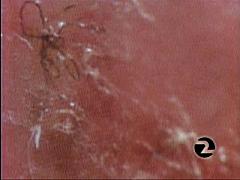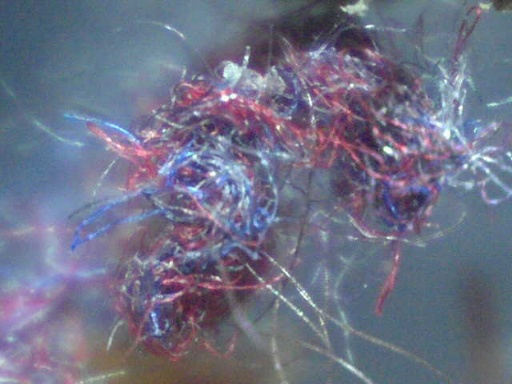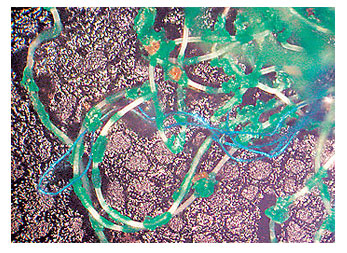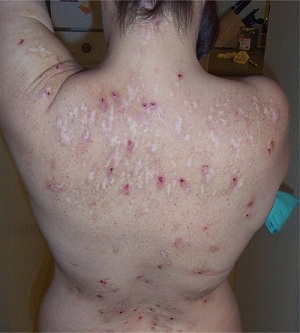NewsRescue; November, 28th 2010

MSNBC- For Emily White, it felt like the worst flu ever. It was in the spring of 2006, and White was pushing through her final term at college. Sure, she was stressed and run-down. But she just didn’t understand how her symptoms could be so intense.
White, then 22, was headed to law school, and would lie awake at night, her mind running nonstop over paying for school, keeping her friendships going, maintaining her 3.8 grade point average and living up to the law-firm job she’d snagged for the summer. She was exhausted, yet sleep was impossible.
This didn’t feel like run-of-the-mill anxiety, though. It was something physical. All over her body — throat, armpits, groin — her lymph nodes swelled up, and she ran a fever. Her face grew lumps, painful and hot, like cystic acne that refused to get better. She dragged herself to class but had trouble putting words together.
And then, within a couple of weeks, the lumps on her face sprouted…something.
At first, she thought they were hairs and tried to yank them with tweezers, but they felt “rooted in cement,” she says. Her skin had always been good; but for the first time in her life, she spackled on concealer to try to hide the bristly rash.
White’s “flu” persisted for months. Her fingers swelled, and her joints ached. She swung between nights of nerve-twanging insomnia and days when she slept so deeply she never heard her alarm. In her first semester of law school, her grade point average plunged to 1.2. During her second semester, in 2007, she went on medical leave and moved in with her parents in northern Connecticut.
[ad#medium]
At about the same time, in a suburb of Seattle, pet-salon owner Alisha Aitken, then 30, was grooming a golden retriever that she’d pampered every month for years. Suddenly, she felt a flush of heat across her body — “as though 100 bees were stinging my face,” she recalls — and ran to a sink to splash herself with cold water.
As she straightened up from the faucet, she caught her image in the mirror. A 2-inch-long filament — stiff, like a dog’s whisker — was emerging from the outer corner of her right eye and running along the skin of her cheek to her lip. When she scraped it off, it left a shallow red scar.
The next day, she broke out in a swollen, oozy rash. A week or so later, confusion set in. Cooking dinner for herself and her toddler daughter one night, she found herself staring at the stove, incapable of comprehending which was the left and which was the right burner. After a couple of months, increasingly sick and unable to focus, she sold her business.
White and Aitken have never met or spoken, but they are two of thousands of people in the United States and a handful of other countries who insist they are suffering from a bizarre new disease that doctors say does not exist. The two women could be imagining things. They could be mentally ill. They also could be, and believe they are, examples of how difficult it is to force medicine to confront something new and strange — a condition that is not in the textbooks, not in the research journals and not on the list of things that insurance companies pay for.
People who are afflicted by such lesions, fibers and bouts of cognitive haze say they hope their status in the eyes of the medical community is about to change. After two years of deliberation, the Centers for Disease Control and Prevention in Atlanta — the federal agency that fields an elite corps of disease detectives — is looking into their complaints. The investigation, which will not report its findings until next year, could explain their weird symptoms or reject them as the inventions of sick minds. White and Aitken say they are absolutely sure they are not crazy. “I’d rather have cancer,” White says. “I know how that sounds. But at least then you get sympathy. And a treatment plan.”
Real or imagined?
The syndrome is being referred to as Morgellons. The name appears in a 1674 essay that describes an outbreak of “harsh hairs…unquiet symptoms…coughs and convulsions” among French children, but whether the moniker refers to the same disease is not known. Mary Leitao, a biologist in a town near Pittsburgh, found the term in a 1935 medical journal article when she was looking for an explanation for an eruption on her 2-year-old son’s lip. She went on to found the Morgellons Research Foundation, a Web-based group of self-described patients that now has more than 12,000 members.

At the time White moved in with her parents, she’d never heard of Morgellons. Her exhaustion, body aches and brain fog had endured for so long that at one point she thought she might have mononucleosis. But mono couldn’t explain the papules that wouldn’t heal or the fibers that grew out of them. White’s doctor, she felt, dismissed her concerns but gave her antibiotics in case she had a low-grade infection. A second doctor did a blood test for various types of cancer. She saw a rheumatologist, who ruled out fibromyalgia. She also saw a dermatologist, who, she says, suggested she had a compulsion that drove her to pick her skin and recommended group therapy. White doesn’t like to discuss it, but her sister confirms that some family members don’t believe she has Morgellons, either.
[ad#medium]
To White, none of the doctors’ explanations made sense. She itched constantly and describes “painful crap” that resembled lint coming from her pores (she used a heating pad to draw it out). At that point, White says, she thought this discharge was hair or fiber from clothes and only mentioned it to her doctors in passing. More worrisome to her were the knotty lumps that had formed under her scalp. When she pressed on them, they seemed to be filled with tangles, as though her hair were growing inward instead of out; she sometimes had the sensation of hair rotating in its follicle. One night, in a fit of rage and fear, she chopped it off at the scalp. When she bathed, she says, black specks and white crystals emerged from her skin.
Desperate, White found a dermatology practice with a physician’s assistant who had heard similar stories from other patients. The physician’s assistant (who spoke to SELF but asked not to be named for fear that her office would become ground zero for Morgellons sufferers who have nowhere else to go) had started out assuming the patients had delusional parasitosis, a recognized psychiatric disorder in which people imagine they are infested with parasites. But their stories were so vivid and similar that she began to wonder whether they had something different, perhaps some kind of an infection. She did a skin biopsy to rule out discoid lupus erythematosus, an autoimmune condition that may make skin react to sunlight and form scars. Then, in July, the physician’s assistant prescribed White a psychiatric drug, pimozide, that affects the action of several brain chemicals and reduces the sensation of itching. The drug didn’t help, but something else did: She also gave White the address of the Morgellons Research Foundation Web site.
The group looked reliable to White. It has eight M.D.s and seven Ph.D.s among its board members, and its founders had published an article introducing the concept of Morgellons in the American Journal of Clinical Dermatology. More compelling were the accounts by self-described patients at the Web site. They told of rashes, weird hairs or fibers, itches, mysterious splinters — and of lives ruined: relatives who didn’t believe them, jobs forfeited, savings depleted by medical visits, and doctors who insisted that the illness was all in their head.
Body Odd: Tangled truth about crazy hair

After five months on the drugs, her anxiety and insomnia improved, as did her swollen glands and rashes. But she was not recovered. “I have lots of Morgellons-specific symptoms that I don’t think are going to fade even with the Lyme treatment,” she says. She still has nodules on her head and the sense of tangles under her scalp, the hair twisting in the follicle. “I don’t know what medicine is powerful enough to make it stop.”
CDC is investigating
New diseases emerge more frequently than most people realize. There has been roughly one per year since the 1970s. Some have a huge impact, such as AIDS; it has killed millions, but it surfaced as a strange pneumonia in five gay men in 1981. Others arrive with barely a ripple, such as the Dandenong virus, which killed three Australian women last year after they all received organs from an unknowingly infected donor.
But deciding whether a new disease exists is a long, contentious process of doing interviews, performing physical exams, conducting lab experiments, crunching data with computers, trawling textbooks for past cases and searching for a reasonable explanation if one isn’t immediately obvious. At the end of the process, disease detectives ideally want to end up with an agent — a bacterium, a virus, a genetic trigger or a toxin — that causes the symptoms they are seeing, a set of symptoms that only one thing can cause. An official designation as a disease means that sufferers are taken seriously; tests are devised to help make a diagnosis, treatments can be researched and insurance usually ends up paying for care.
The more cryptic the cause or symptoms are, the longer the process takes and the harder it is for the medical establishment to recognize a new disease. West Nile virus was a well-known, generally mild illness in Europe, Africa and the Middle East — but when the virus crossed the Atlantic in 1999 and caused brain inflammation in 59 New Yorkers, killing seven of them, doctors didn’t immediately recognize it because the symptoms were so different. Women complained of chronic pain, stiffness and fatigue for decades before organized medicine recognized the syndrome as fibromyalgia. For years afterward, rank-and-file doctors refused to diagnose it, in part because medical research has not uncovered a definite cause. “A lot of new diseases came up in the 20th century that people scoffed at,” says Howard Markel, M.D., professor and director of the Center for the History of Medicine at the University of Michigan Medical School in Ann Arbor.

Patients, naturally, feel patronized. With medical opinion so uniformly against them, they made their own Morgellons community on the Internet. There are two major organizations, the Morgellons Research Foundation and the Charles E. Holman Foundation, as well as 720 videos on YouTube and 20 groups on Yahoo! where people compare symptoms and discuss such topics as trying veterinary drugs as remedies. The online presence brings sufferers individual comfort and group power: The MRF claimed the CDC began investigating the syndrome in part because it was prompted by “more than 40 members of Congress” responding to its members’ letters.
Ironically, though, the virtual Morgellons community might be undermining the validation its sufferers are seeking. Medical history abounds with accounts of people getting sick because they heard or saw it happening to someone else, a phenomenon that used to be called hysteria and now goes by the more polite psychogenic illness. It has caused outbreaks of itching, fainting and difficulty breathing, along with mass panic attacks such as several in Africa and Asia in which hundreds of men came to believe that their penis was shrinking back into their body. Timothy F. Jones, M.D., an epidemiologist with the Tennessee Department of Health, investigated a 1998 episode in which 170 high school students and staff went to emergency rooms after smelling “toxic fumes” that were never proven to exist. He says psychogenic outbreaks spread rapidly, usually among people within sight of one another, and dissipate quickly when the affected people are separated.
That is not exactly what has happened with Morgellons. Its community accumulated over several years, and most of its members have never met. Still, cybersharing may have profound suggestive power. Chat groups and social-networking sites have been accused of fostering anorexia and suicide clusters. Morgellons accounts may have influenced psychologically vulnerable people to adopt the syndrome as their own — including people who are authentically sick but mistaken about the cause, Dr. Jones says.
That sufferers are sharing information about Morgellons on the Internet could also foil the search for an explanation. Epidemiologists consider unrelated people telling the same story to different doctors to be a reliable early warning signal of a new illness, but publicity is the medical equivalent of polluting the jury pool. That means when disease detectives question patients, their responses might be influenced by what they’ve heard, making some studies impossible to do. “Say you have an outbreak of food-borne illness,” Dr. Jones says. “If you ask people to tell you their symptoms, they might say, ‘Nausea and vomiting.’ But if you read them a list of symptoms, they will say, ‘Oh, I had that, too.’ It’s not a conscious thing; it’s the power of suggestion.”
But even if patients have altered their stories in the retelling, there are so many tales that investigators are nonetheless likely to listen. “If it’s just one person saying, ‘I got this rash’ or ‘I got these fiber lesions,’ that’s one thing,” says Dr. Markel, the medical historian. “If there are thousands of them, that’s another thing. That is very compelling and at least merits a hearing.”
Is it a new disease?
The job of figuring out if Morgellons is, in fact, a distinct disease falls to Michele Pearson, M.D., the physician and epidemiologist directing the CDC study. Dr. Pearson trained in the raucous, violent emergency rooms of downtown Chicago before heading to the CDC. She says it is time for the CDC to tackle whatever the illness may be. “A number of people were calling in, not only those affected but providers, saying, ‘I’m seeing these patients; what should I do?’ and public-health professionals saying, ‘We’re getting reports to our health departments,’” she says, estimating that the CDC gets about 100 calls and e-mail messages about Morgellons each month. Dr. Pearson has spoken to a number of the Morgellons callers and met several and was moved by their plight. She says she is unwilling to prejudice her investigation by speculating on whether Morgellons is a medical problem, a psychiatric disorder or a media creation. Whatever the cause turns out to be, “the suffering these patients are experiencing is real,” she says.
Perhaps her most delicate task is to respect Morgellons patients’ pain and frustration without betraying the scientific rigor for which the CDC is internationally known. So the agency is moving cautiously. Its preliminary objectives are to understand Morgellons symptoms (the first step in sorting out how common the illness is), who is most vulnerable and what the cause might be. The study is a joint project with the northern California research division of the giant HMO Kaiser Permanente. California seems to be a Morgellons hot spot, and Kaiser uses electronic medical records — which allows investigators to search among 3.5 million patients for complaints of fibers and either skin lesions and/or itching or crawling sensations.
In May and June, investigators began inviting possible sufferers to Kaiser’s Oakland offices. Volunteers, who have taken a detailed survey about symptoms, travel history and their pets, among other things, submit to a physical exam and a neurological and psychological evaluation. This looks for evidence of the brain fog patients complain of and also pinpoints any problems such as obsessive-compulsive disorder and depression that might complicate the analysis. Finally, volunteers give blood and skin samples for a wide range of lab tests. All the data generated, hundreds of pieces of information per volunteer, will be poured into computer programs that look for patterns and anomalies. “At this point, it’s really basic information that we don’t know: Is it primarily men or women? Is it primarily the old or the young? Is it primarily people from certain racial or ethnic groups or socioeconomic backgrounds?” Dr. Pearson says. “This [research] will put a face on it.”
Strange symptoms
For months after the episode that launched her illness, Alisha Aitken says she has struggled with swollen, cystic lumps on her face and neck that turned raw and sticky “with the slightest touch of a T-shirt.” The lesions took months to heal and left her with scars that make her reluctant to be photographed, she says. She saw several doctors who offered different diagnoses: dermatitis, eczema, psoriasis. “They didn’t know what was going on, and I didn’t know what was going on either,” she says. “They did the best they could with what they had been given in medical school.”
With traditional medicine no help to her, she turned to alternative treatments, slathering her skin with molasses and zinc oxide (which did not help) and taking herbs to aid her memory and sleep. And, like White, she searched on the Internet for accounts that matched her symptoms. “Nothing fit, and then I found Morgellons and it fit to a T,” says Aitken, who now lives in Clarkston, Washington, with her daughter and longtime boyfriend.
Through the Charles Holman Foundation, Aitken found Randy Wymore, Ph.D., a medical school professor at Oklahoma State University at Tulsa who has become an unexpected champion of the Morgellons community. He was doing an Internet search on muscle fibers in the spring semester of 2005 when he stumbled onto a Web site discussing a fiber disease. Intrigued, he read for a moment, thought it seemed crazy, closed the link and went back to his other work. But the topic nagged at him, and a few days later he called up the search again.
Wymore says he assumed the people posting were unhinged and spinning wild obsessions out of dryer lint and pet hair. To satisfy his own curiosity, he e-mailed a few of those who had posted, inviting them to send him some fibers for analysis. “I was quite expecting people to say things like, ‘Well, if we try and ship them to you, they’ll disappear,’ or, ‘You can’t see them unless you have the disease, too,’” he recalls. “But 24 hours later, FedEx packages started arriving.”
He fished the samples — too small to study without a microscope — out of the packages and popped them onto a slide. “I didn’t know what to make of them,” Wymore says. Before he analyzed them, he collected fiber samples from his own life: sweater snags, threads from his jeans, dust bunnies. The samples from the patients did not look like these: tightly tangled, vividly red, blue, brownish, as well as some that were clear and smooth. He began collecting fibers everywhere he went — from his house, the medical school’s carpet, the hotel rooms his family stayed in on summer vacation, the pets at his daughter’s elementary school. Nothing he gathered looked like the Morgellons samples — but the samples, which by now had come from Texas, Washington, California, Pennsylvania and Florida, all looked similar to each other.
He and a colleague, pediatrician Rhonda Casey, M.D., then persuaded about 30 adults and children who claimed to have Morgellons to come in for interviews and physicals. They looked ill, sometimes thin and lacking in energy, and some had slurred speech. And Dr. Casey found something odd: tangled skeins of dark fibers, not stuck to the surface of rashes or popping out of pores, but buried in intact skin. Wymore asked two forensic experts at the Tulsa Police Department who had access to national fiber-identification databases to have a look at the fiber samples. They were stumped, he says. The fibers had no cuts or extrusion marks that would establish them as man-made and no internal structures such as cell walls that would make the case for natural origin. The fibers did not lose their color in any solvents or detergents. At 1,600 degrees Fahrenheit, they did not burn.
“So if you’d like a hypothesis as to what might be causing Morgellons, I can’t give you one,” Wymore says. “But there is no question that Morgellons is some sort of physical pathology. It is not a psychiatric disorder. And until someone else starts researching this in a fairly significant way, I can’t just go back to my other work and say, ‘Well, good luck, all you Morgellons people. Hope they figure this out.’”
White and Aitken have been living with their strange symptoms, and with the burden of being thought insane, for almost three years. “It’s unnerving to know more about your condition than your doctor,” White says. For both of them, being doubted has become a strange status quo, weirdly familiar without ever being welcome. “I don’t hold any hope in the CDC or any doctors, really,” says Aitken, who adds she is feeling better because she reduced the stress in her life and began using a nonmainstream medical treatment involving infrared heat. “Nobody really knows what is going on.”
As for White, she had been feeling better with fewer visible fibers on her skin. But she says the sense of hair “growing down” into her scalp is more pronounced than it was before. She started working this past summer, but her confident college-girl assumption that life will go well has been irrevocably shattered, and that seems as big a loss as her health. “If I got hit by a truck tomorrow, I don’t think I would be too upset about it — not because I’m suicidal, but more that I don’t know if I want to live this way for however many years I’m going to live,” she says. “Normal is not anything I ever aspired to be, but I don’t feel like I’m ever going to feel normal again.” source




